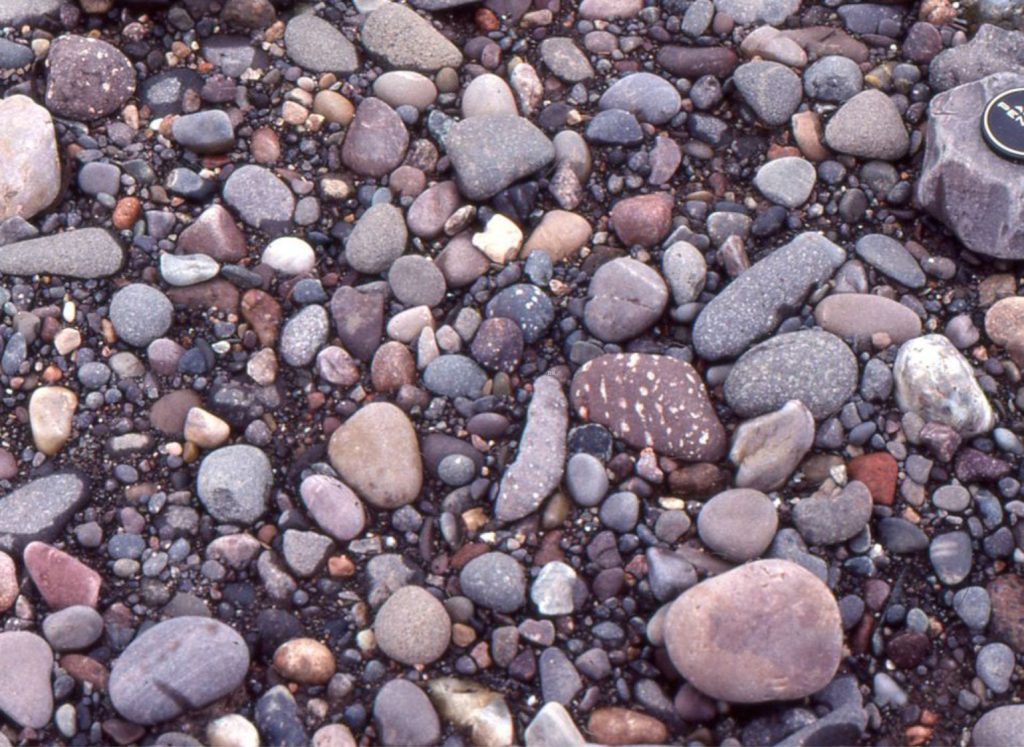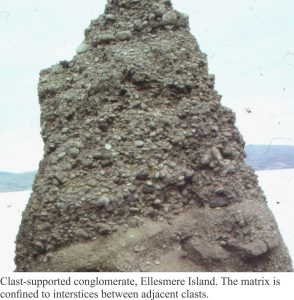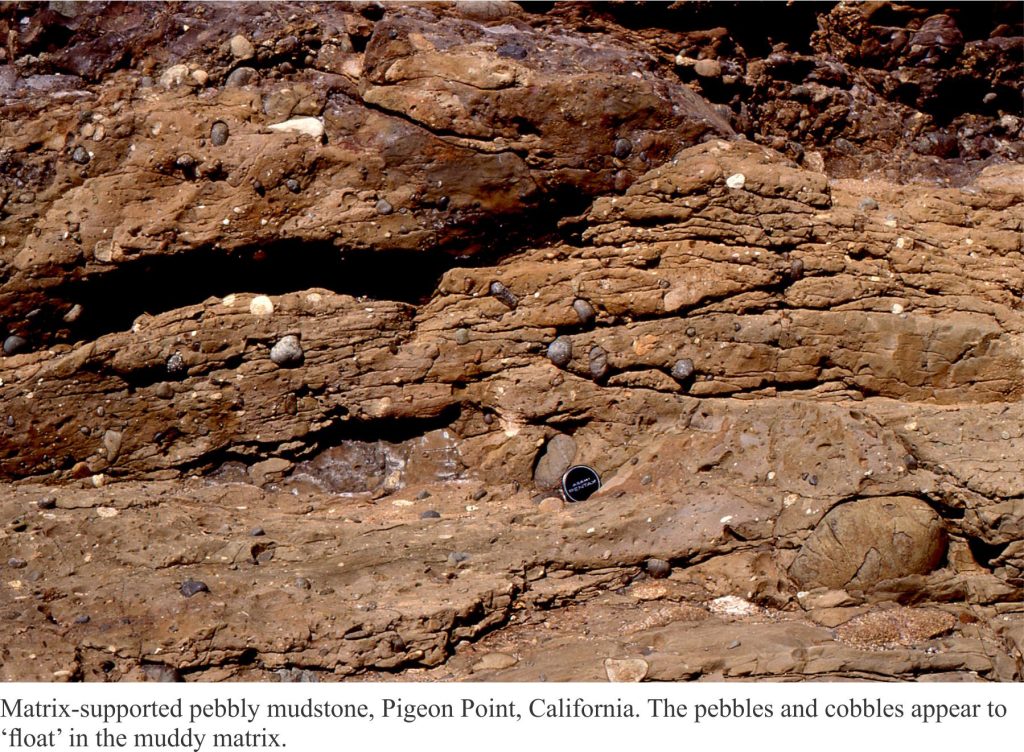This post is part of the How To… series
Once you have read this article, you may find it useful to look at some specific examples in:
Paleontology for sedimentologists
The formation of sediment and sedimentary rock involves many physical, chemical and biological processes, sometimes operating separately but more commonly in concert. The journey from loose sediment to hammer-ringing rock is one of the marvels of the geological world. Deciphering this journey requires us to delve into the rock record. To do this we need a starting point – we need to know what it is we’re looking at and be able to communicate this information to others.
Asking how one describes sedimentary rocks is a bit like questions about bits of string; there is a bewildering array of them, each deserving a rational description. Fortunately, the guidelines for this task are well established. We have a century and a half of sedimentology icons to thank for this: Sorby, Wentworth, Twenhofel, Folk, Pettijohn, Potter, and Bathurst, to name a few.
Decades of collective experience allows us to place sedimentary rocks into four broad categories:
- Siliciclastic (or terrigenous) deposits contain fragments derived by erosion or weathering of older rocks. The fragments range in size from house-sized blocks to micron-sized clays – conglomerate and breccia (gravel in an unconsolidated state), sandstone-siltstone (sand and silt), and mudrocks (mixtures of silt, and clay-sized fragments or crystals). They represent the recycling of material across Earth’s surface. Some sediment components can survive more than one cycle of deposition, burial and induration (hardening), uplift, and erosion – quartz grains fit this category well, as do grains of zircon because of their chemical stability and hardness that enables them to withstand the rigours of erosion and deposition.
- Sediments derived primarily by biogenic processes (biological and biochemical) include carbonates (limestones and dolostones), peat, coal, and other accumulations of organic matter such as oil shale, and phosphates. These deposits may also contain fragmental debris, such as bioclastic fragments in limestones (e.g. coral, molluscs), but unlike multicycle siliciclastics the primary constituents are directly associated with organic processes; they are mostly first-cycle deposits.
- Chemical deposits include those formed directly by precipitation from saline water. The most common deposits in this category include evaporites (halite, gypsum), iron formations (particularly those in the Precambrian), and siliceous deposits that form chert (in Precambrian iron formations iron oxide precipitates and chert are commonly found together). As a general rule the environments of precipitation are low energy where the influx of siliciclastic sediment is low.
- Volcaniclastics represent fragmental debris derived from volcanic eruptions. This includes air-fall ash (tephras) and pyroclastic flow deposits (e.g. hot and cold ignimbrites) that are derived directly from eruption events, and material that is redeposited by lahars or subaqueous sediment gravity flows (turbidites, debris flows).
Like most classification schemes, particularly one as all-encompassing as this, there are exceptions – in fact exceptions are quite common. Mixed siliciclastic-carbonate deposits are common in stratigraphic intervals that are transitional between carbonate-dominated and siliciclastic-dominated environments. Precambrian iron formations, like the Gunflint Formation in southern Ontario, may contain coarse-grained fragmental deposits and stromatolites that indicate high energy shoreline or shallow marine environments. Volcaniclastic debris that is redeposited may incorporate siliciclastic or biogenic carbonate material. We could deal with all these exceptions with a bit of fine tuning, subdividing each category into any number of variants, but I’ll leave that for others to do (I’m more a lumper than a splitter).
The posts that follow deal with sedimentary rock description at the hand-sample – outcrop scale. The descriptors were invented not just for the sake of description, but to provide fundamental links to depositional processes such as hydraulics, and the mechanical winnowing or sorting of grains based on shape and density. Our descriptions make use the following physical sediment properties:
- Colour. This may seem pretty basic but colour provides valuable information about environmental conditions such as REDOX chemistry (i.e. the reduction-oxidation potential of chemical constituents), particularly the oxidation state of iron. For example, iron is in a reduced 2+ state in green mudrocks, and an oxidized state (3+) in terrestrial red beds.
- Texture. This is a broad term that includes qualities like clast framework, and quantities like grain size and shape, and grain size distributions from which we can estimate statistical measures of central tendency, and standard deviations that sedimentologists refer to as sorting. Note that the term ‘grain’ is used here to mean any kind and size of clast, such as siliciclastic sand and gravel, or carbonate bioclasts and oolites.
- Fabric, is a textural property that describes the orientation of clasts (including fossils). Common fabrics include parting lineation that develops from the alignment of individual sand grains, and imbrication of platy clasts in gravels. Sedimentary fabrics like these record paleocurrent flow directions.
- Porosity is a measure of the void, or pore space between adjacent grains. At the point of deposition, all sediments have porosity. Weakly indurated rocks tend to retain some of their original porosity, but this decreases as compaction and cements develop.
Sediment framework and matrix. The literature on sedimentology is replete with references to attributes like “clast-supported framework”. What does this mean? Frameworks in this context refer to the essential ingredients that make something a sandstone, a conglomerate, a coquina – in other words the sand grains, pebbles cobbles and boulders, and bioclasts, respectively. Sediment framework is basically all the large bits.
Matrix refers to the fine-grained sediment, commonly clay, silt and fine sand sized material that occurs between or separates framework clasts. Matrix is a depositional product; it accumulates with the framework. Matrix clays are prone to alteration during burial diagenesis.
These definitions may seem a bit vague. We tend to make the distinction between framework and matrix only in ‘coarse-grained’ deposits. Trying to decide what is framework in mudrocks is next to impossible – they are mostly matrix. Given this seemingly arbitrary distinction, why do we bother? The main reason is that identifying these textural properties helps us decipher depositional processes. Consider the two conglomerates shown above. The one on the left consists of clasts that are in direct contact such that the framework is clast-supported; the interstitial matrix here is a small amount of mud and sand. The second example also contains pebbles and cobbles but in this case they are separated by muddy sediment; they appear to ‘float’ in the matrix – this is a matrix-supported framework. In each case, the hydraulic conditions associated with their deposition were very different. On the left, flowing water was energetic and continuous enough to move gravel and remove most of the finer sediment. On the right, the flow was energetic enough to move the gravel but not continuous enough to remove the matrix. The clast-supported conglomerate was deposited by a braided river where sediment was washed and reworked by strong currents, and the matrix-supported conglomerate by a submarine debris flow in which pebbles and cobbles were thoroughly mixed and transported as a muddy torrent – in this case there was no mechanism to remove the matrix.
Keep in mind that all the above properties can change during sediment burial. Diagenetic features are usually determined by examining thin sections with a polarizing microscope. Physical compaction and chemical diagenesis can:
- Change the organization of grains one to the other (i.e. their framework),
- Change the shape of softer grains,
- remove some grains by dissolution (e.g. fossil fragments, or feldspars) – this is one mechanism that creates secondary porosity,
- result in an increase in grain size as a result of precipitation; common examples of this are quartz overgrowths on quartz grains, and
- produce cements that replace matrix and in some cases framework clasts.
Bedding
Sedimentary rocks are usually contained within beds – beds of different geometric configurations and thicknesses. Beds are the fundamental units in stratigraphy. Thus, descriptions of sediments and sedimentary rocks will normally contain reference to bedding – its thickness areal or outcrop extent, geometry, and the nature of the bedding planes. Check out the post on Beds and bedding planes for more detailed descriptions and analysis.
Some other useful posts in this series:
Analysis of grain size distributions
Some controls on grain size distributions
Measuring a stratigraphic section
Crossbedding – some common terminology
The hydraulics of sedimentation: Flow Regime




















